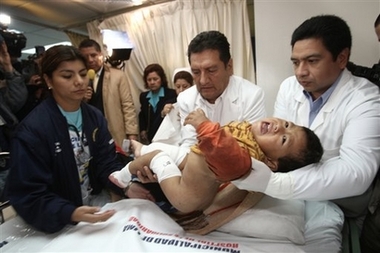Survivors of Peru quake fear aftershocks
Updated: 2007-08-17 22:55
 A boy injured during an earthquake that hit the area late Wednesday, receives medical attention at a public hospital in Lima, Thursday, Aug. 16, 2007. [AP] |
Felipe Gutierrez, 82, sat in his pajamas - his only clothing - in front of what was his Pisco home. The quake reduced it to rubble and he, his 74-year-old wife, their two children and three grandchildren sat staring at the ruins, a tangle of adobe, straw and all of their belongings.
"Yesterday we slept on a mattress, and now we'll have to set up a tent, because we have nowhere to live," he said.
|
|||
The earthquake's magnitude was raised from 7.9 to 8 on Thursday by the US Geological Survey. Dozens of aftershocks - including at least six on Friday - caused renewed anxiety, though there were no reports of additional damage or injuries.
President Alan Garcia flew by helicopter to Ica, a city of 120,000 where a quarter of the buildings collapsed, and declared a state of emergency.
Government doctors called off their national strike for higher pay to handle the emergency.
"There has been a good international response even without Peru asking for it, and they've been very generous," Garcia said during a stop in Pisco.
The help includes cash from the United States, United Nations, Red Cross and European Union as well as tents, water, medicine and other supplies. The US Navy hospital ship Comfort, equipped with a staff of 800 and 12 operating rooms, is in Ecuador and could quickly sail to Peru if asked, US officials said.
In Washington, US President Bush offered condolences and said his administration was studying how best to send help. One American died in the quake, according to the US State Department.
Electricity, water and phone service were down in much of southern Peru. The government rushed police, soldiers and doctors to the area, but traffic was paralyzed by giant cracks and fallen power lines on the Panamerican Highway.
In Chincha, a small town near Pisco only 25 miles from the quake's epicenter, an AP Television News cameraman counted 30 bodies on a hospital patio. The face of one victim was uncovered, her eyes open. The feet of another stuck out from under a blanket.
Hundreds of injured lay side-by-side on cots on walkways and in gardens outside hospital buildings.
"Our services are saturated and half of the hospital has collapsed," Dr. Huber Malma said as he single-handedly attended to dozens of patients.
In Lima, 95 miles from the epicenter, only one death was recorded. But the furious two minutes of shaking prompted thousands to flee into the streets and sleep in public parks.
Scientists said the quake was a "megathrust" - a type of earthquake similar to the catastrophic Indian Ocean temblor in 2004 that generated deadly tsunami waves. "Megathrusts produce the largest earthquakes on the planet," USGS geophysicist Paul Earle said.
In general, magnitude 8 quakes are capable of causing tremendous damage. Quakes of magnitude 2.5 to 3 are the smallest generally felt, and every increase of one number on the magnitude scale means that the quake's magnitude is 10 times as great.
The temblor occurred in one of the most seismically active regions in the world at the boundary where the Nazca and South American tectonic plates meet. The plates are moving together at a rate of 3 inches a year, Earle said.
|
|
|
||
|
||
|
|
|
|





